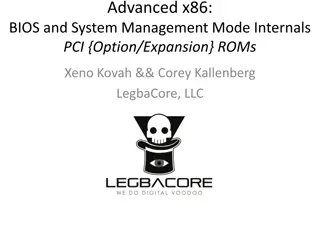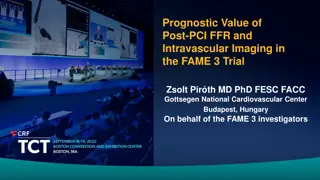Ticagrelor Monotherapy vs. Ticagrelor + Aspirin in High-Risk PCI Patients: TWILIGHT-COMPLEX Study
Patients undergoing complex PCI are at high risk of ischemic events. The TWILIGHT-COMPLEX study aims to compare the safety and efficacy of ticagrelor monotherapy versus ticagrelor with aspirin in patients who completed 3 months of DAPT post-PCI. While extended DAPT may reduce ischemic events, it also increases bleeding risk. The study explores whether ticagrelor monotherapy can mitigate bleeding complications without raising ischemic risks in high-risk PCI patients.
Download Presentation

Please find below an Image/Link to download the presentation.
The content on the website is provided AS IS for your information and personal use only. It may not be sold, licensed, or shared on other websites without obtaining consent from the author.If you encounter any issues during the download, it is possible that the publisher has removed the file from their server.
You are allowed to download the files provided on this website for personal or commercial use, subject to the condition that they are used lawfully. All files are the property of their respective owners.
The content on the website is provided AS IS for your information and personal use only. It may not be sold, licensed, or shared on other websites without obtaining consent from the author.
E N D
Presentation Transcript
Ticagrelor With AspIrin or ALone In HiGH-Risk PaTients After Complex Percutaneous Coronary Intervention: The TWILIGHT-COMPLEX Study George D. Dangas, MD, PhD, FACC, FAHA, MSCAI on behalf of the TWILIGHT Investigators Professor of Medicine (Cardiology) & Surgery (Vascular) Icahn School of Medicine at Mount Sinai, New York, NY, USA
Declaration of Interest The TWILIGHT Trial Sponsoring organization: Icahn School of Medicine at Mount Sinai, NY Funded by AstraZeneca Coordinated by Icahn School of Medicine at Mount Sinai, NY
Presenter Disclosure Information Name: George D. Dangas Within the past 12 months, the presenter or their spouse/partner have had a financial interest/arrangement or affiliation with the organization listed below. I received payment as an individual for: a) Abbott Vascular: consulting fees b) Boston Scientific: consulting fees c) Biosensors: consulting fees Common stock (entirely divested): Medtronic Institutional payments for research grants: a) Astra Zeneca b) Bayer c) Daiichi-Sankyo
Background Patients who undergo complex PCI are at high risk of ischemic events 1,2. This risk is higher with increments in PCI complexity and may be reduced by extending DAPT 3. On the other hand (regardless of PCI complexity) extension of DAPT duration is associated with increased risk for major bleeding, which is in turn associated with increased morbidity, mortality and healthcare cost 4. A strategy of withdrawing aspirin and maintaining P2Y12 inhibitor monotherapy after a brief period of DAPT has emerged a potential bleeding reduction strategy 5. In particular, the TWILIGHT study showed that monotherapy with the potent P2Y12-receptor inhibitor ticagrelor after 3 months of DAPT was associated with a lower incidence of clinically relevant bleeding, without increasing the risk of ischemic events compared to continuing DAPT 6. Whether such an approach mitigates bleeding complications, without increasing ischemic risk in patients who undergo complex PCI is unknown. 1. Giustino et al. J Am Coll Cardiol 2016;68:1851-1864. 2. Genereux et al. Int J Cardiol 2018;268:61-67. 3. Serruys et al. Eur Heart J 2019;40:2595-2604. 4. Baber et al. JACC Cardiovasc Interv 2016;9:1349-57. 5. Capodanno et al. Nature Reviews Cardiology 2018;15:480-496. 6. Mehran et al. N Engl J Med 2019;381:2032-2042.
TWILIGHT-Complex: Study Objective Post-hoc analysis of the TWILIGHT trial To evaluate the safety and efficacy of a regimen of ticagrelor monotherapy versus ticagrelor plus aspirin, in patients who initially completed 3 months of DAPT after complex PCI.
TWILIGHT-Complex: Study Design Randomized, double-blind placebo-controlled trial in 187 sites and 11 countries. High-risk PCI patients treated with ticagrelor plus aspirin for 3 months. Event-free and adherent patients were randomized to aspirin versus placebo and continued ticagrelor for an additional 12 months. Enrolled PCI Patients (N = 9006) Ticagrelor + Aspirin Standard of Care Enrolled Complex PCI (N = 2956) Randomized Complex PCI 2620 Ticagrelor + Placebo Standard of Care Dangas et al, JACC 2020 Randomization Period 12 Months Observation Period 3 Months Post Enrollment Period 3 Months 3 M 15 M 18 M
TWILIGHT Inclusion/Exclusion Criteria Patients Must meet at least 1 clinical AND 1 angiographic criterion Clinical criteria Angiographic criteria Age 65 years Multivessel CAD Female gender Target lesion requiring total stent length >30mm Troponin positive ACS Thrombotic target lesion Established vascular disease (previous MI, documented PAD or CAD/PAD revascularization) Bifurcation lesion(s) with Medina X,1,1 classification requiring 2 stents DM treated with medications or insulin Left main ( 50%) or proximal LAD ( 70%) lesions CKD (eGFR <60ml/min/1.73m2 or CrCl <60ml/min) Calcified target lesion(s) requiring atherectomy Key Exclusions: STEMI; Salvage PCI; need for chronic oral anticoagulation; planned repeat coronary revascularization
TWILIGHT-Complex: Methods Target Population Randomized TWILIGHT participants undergoing complex PCI, as defined below. Complex PCI included PCI with at least 1 of the following characteristics: 3 vessels treated 3 lesions treated total stent length >60 mm bifurcation with 2 stents implanted use of any atherectomy device left main as target vessel venous or arterial bypass graft as target lesion chronic total occlusion of target lesion Endpoints Primary: BARC 2, 3 or 5 bleeding between 0 - 12 months after randomization Secondary: All-cause death, non-fatal MI or stroke between 0 - 12 months after randomization Dangas et al, JACC 2020
TWILIGHT-Complex: Methods Statistical Analysis Analyses were performed in the intention-to-treat population for bleeding endpoints and in the per- protocol population for ischemic endpoints. The cumulative incidence of the primary and secondary endpoints was estimated by Kaplan Meier methods. Hazard ratios (HR) and 95% confidence intervals were generated with Cox proportional-hazards models. The consistency of the treatment effects of ticagrelor monotherapy versus ticagrelor plus aspirin between the complex and non-complex PCI subgroups was evaluated with formal interaction testing. Dangas et al, JACC 2020
TWILIGHT-Complex: Study Flow Total Enrolled 9006 Complex Enrolled 2956 (32.8%) Non-Complex Enrolled 6050 (67.2%) Total Randomized 7119 Complex Randomized 2342 (32.9%) Non-Complex Randomized 4777 (67.1%) R R Ticagrelor + Placebo 1158 (49.4%) Ticagrelor + Aspirin 1184 (50.6%) Ticagrelor + Placebo 2397 (50.2%) Ticagrelor + Aspirin 2380 (49.8%) Dangas et al, JACC 2020
TWILIGHT-Complex: Patient Characteristics Baseline Demographics Complex PCI (N = 2342) Non-Complex PCI (N = 4777) Variable p-value 66.0 10.4 498 (21.3%) 803 (34.3%) 28.1 5.3 64.7 10.3 1200 (25.1%) 1393 (29.2%) 28.8 5.7 <0.0001 <0.0001 <0.0001 <0.0001 <0.0001 Age, years [Mean SD] Female sex Non-white race BMI, kg/m2 [Mean SD] Enrolling region North America Europe Asia Chronic Kidney Disease Anemia Acute Coronary Syndrome presentation Current Smoker Previous Myocardial Infarction Previous PCI Previous CABG Previous major bleeding episode 916 (39.1%) 796 (34.0%) 630 (26.9%) 405 (18.1%) 479 (21.4%) 1488 (63.6%) 483 (20.6%) 672 (28.7%) 971 (41.5%) 361 (15.4%) 23 (1.0%) 2056 (43.0%) 1713 (35.9%) 1008 (21.1%) 740 (16.1%) 850 (18.5%) 3126 (65.4%) 1065 (22.3%) 1368 (28.6%) 2027 (42.4%) 349 (7.3%) 40 (0.8%) 0.04 0.004 <0.0001 0.11 0.96 0.44 <0.0001 0.54 Dangas et al, JACC 2020
TWILIGHT-Complex: Patient Characteristics Baseline Angiographic & Procedural Details Complex PCI (N = 2342) Non-Complex PCI (N = 4777) Variable p-value 1734 (74.0%) 1.6 0.7 2732 (57.2%) 1.2 0.4 <0.0001 <0.0001 Multivessel CAD Number of vessels treated Target vessel LAD RCA LCX Venous or arterial bypass graft Left Main Disease 50% Number of lesions treated [Mean SD] Lesion morphology Calcification, moderate/severe Any bifurcation Chronic total occlusion Total stent length [Mean SD] 1429 (61.0%) 996 (42.5%) 874 (37.3%) 161 (6.9%) 353 (15.1%) 2.1 0.9 2574 (53.9%) 1504 (31.5%) 1423 (29.8%) 0 (0.0%) 0 (0.0%) 1.3 0.4 <0.0001 <0.0001 <0.0001 <0.0001 0.14 <0.0001 506 (21.6%) 502 (21.4%) 446 (19.0%) 59.6 29.4 481 (10.1%) 364 (7.6%) 0 (0.0%) 30.2 13.1 <0.0001 <0.0001 <0.0001 <0.0001 Dangas et al, JACC 2020
TWILIGHT: Components of Complex PCI 60% 51.8% 50% Prevalence (%) 40% 29.9% 30% 19.0% 20% 15.1% 10.7% 10.4% 9.1% 6.9% 10% 0% 3 vessels treated (N=214) >60 mm total stent length (N=1214) Use of atherectomy device (N=244) Bifurcation with 2 stents (N=251) CTO as target lesion (N=446) Surgical bypass graft as target lesion (N=161) Left main as target lesion (N=353) 3 lesions treated (N=701) Dangas et al, JACC 2020
TWILIGHT-Complex: BARC 2, 3 or 5 Bleeding Intention-To-Treat Cohort Ticagrelor + Placebo Ticagrelor + Aspirin HR (95% CI) pint 0.10 Complex PCI 4.2% 7.7% 0.54 (0.38-0.76) 0.79 BARC type 2, 3 or 5 Non-complex PCI 3.9% 6.8% 0.57 (0.44-0.73) 0.05 0.0 0 60 120 180 240 300 360 Days after randomization Number at risk 2380 2331 2291 2256 2216 2184 2154 Ticagrelor + Aspirin - Non-Complex 2397 2365 2340 2314 2282 2263 2244 Ticagrelor + Placebo - Non-Complex 1184 1157 1130 1107 1090 1077 1061 Ticagrelor + Aspirin - Complex 1158 1133 1123 1115 1098 1086 1077 Ticagrelor + Placebo - Complex Ticagrelor + Aspirin Complex PCI Ticagrelor + Aspirin Non-complex PCI Dangas et al, JACC 2020 Ticagrelor + Placebo Complex PCI Ticagrelor + Placebo Non-complex PCI
TWILIGHT-Complex: BARC 3 or 5 Bleeding Intention-To-Treat Cohort 0.10 Ticagrelor + Placebo Ticagrelor + Aspirin HR (95% CI) pint BARC type 3 or 5 Complex PCI 1.1% 2.6% 0.41 (0.21-0.80) 0.47 Non-complex PCI 0.9% 1.7% 0.56 (0.33-0.94) 0.05 0.0 0 60 120 180 240 300 360 Days after randomization Number at risk 2380 2353 2338 2328 2307 2290 2273 Ticagrelor + Aspirin - Non-Complex 2397 2376 2366 2347 2328 2320 2313 Ticagrelor + Placebo - Non-Complex 1184 1172 1159 1146 1136 1129 1120 Ticagrelor + Aspirin - Complex 1158 1140 1135 1131 1118 1116 1110 Ticagrelor + Placebo - Complex Ticagrelor + Aspirin Complex PCI Ticagrelor + Aspirin Non-complex PCI Ticagrelor + Placebo Complex PCI Ticagrelor + Placebo Non-complex PCI Dangas et al, JACC 2020
Prespecified Bleeding Endpoints (ITT) TWILIGHT Complex PCI Patients Ticagrelor + Placebo Ticagrelor + Aspirin HR [95% CI]: 0.54 [0.38 0.76] 10% Cumulative incidence (%) 7.7% 8% HR [95% CI]: 0.41 [0.22 0.79] HR [95% CI]: 0.41 [0.21 0.80] 6% HR [95% CI]: 0.51 [0.24 1.09] 4.2% 4% 2.7% 2.6% 1.7% 2% 1.1% 1.1% 0.9% 0% BARC 3 or 5 TIMI minor or major GUSTO moderate or severe ISTH major All pinteraction >0.05 Dangas et al, JACC 2020
Bleeding Events With and Without Complex PCI Complex PCI patients (N = 2342) Non-Complex PCI patients (N = 4777) Interaction p-value Variable Tica + Placebo (N = 1158) Tica + Aspirin (N = 1184) HR Tica + Placebo (N = 2397) Tica + Aspirin (N = 2380) HR (95% CI) (95% CI) no. of patients (%) no. of patients (%) 0.54 0.57 48 (4.2%) 90 (7.7%) 93 (3.9%) 160 (6.8%) 0.79 BARC 2, 3 or 5 (0.38 0.76) (0.44 0.73) 0.41 0.56 12 (1.1%) 30 (2.6%) 22 (0.9%) 39 (1.7%) 0.47 BARC 3 or 5 (0.21 0.80) (0.33 0.94) 0.54 0.57 48 (4.2%) 90 (7.7%) 93 (3.9%) 160 (6.8%) 0.79 TIMI minor or major (0.38 0.76) (0.44 0.73) 0.51 0.55 GUSTO moderate or severe 10 (0.9%) 20 (1.7%) 16 (0.7%) 29 (1.2%) 0.89 (0.24 1.09) (0.30 1.01) 0.41 0.64 13 (1.1%) 32 (2.7%) 26 (1.1%) 40 (1.7%) 0.29 ISTH major (0.22 0.79) (0.39 1.05) Dangas et al, JACC 2020
TWILIGHT-Complex: Death, MI or Stroke Per-Protocol Cohort 0.10 All-cause death, MI or stroke Ticagrelor + Placebo Ticagrelor + Aspirin HR (95% CI) pint Complex PCI 3.8% 4.9% 0.77 (0.52-1.15) 0.13 Non-complex PCI 3.9% 3.5% 1.13 (0.84-1.53) 0.05 0.0 0 60 120 180 240 300 360 Days after randomization Number at risk Ticagrelor + Aspirin - Non-Complex 2356 2327 2314 2300 2275 2256 2238 Ticagrelor + Placebo - Non-Complex 2372 2342 2321 2302 2276 2260 2246 Ticagrelor + Aspirin - Complex 1159 1147 1132 1118 1107 1099 1085 Ticagrelor + Placebo - Complex 1152 1133 1123 1114 1099 1096 1084 Ticagrelor + Aspirin Complex PCI Ticagrelor + Aspirin Non-complex PCI Ticagrelor + Placebo Complex PCI Dangas et al, JACC 2020 Ticagrelor + Placebo Non-complex PCI
Prespecified Ischemic Endpoints (PP) Complex PCI Patients Ticagrelor + Placebo Ticagrelor + Aspirin 10% HR [95% CI]: 0.75 [0.50 1.12] Cumulative incidence (%) 8% HR [95% CI]: 0.83 [0.52 1.32] 6% 4.8% HR [95% CI]: 0.59 [0.27 1.29] HR [95% CI]: 0.56 [0.19 1.67] 3.6% 3.5% 4% HR [95% CI]: 0.50 [0.05 5.56] 2.9% 1.5% 2% 0.9% 0.8% 0.4% 0.2% 0.1% 0% CV Death, MI or Ischemic Stroke All-cause Death MI, any Ischemic Stroke Stent thrombosis (definite/probable) All pinteraction >0.05 Dangas et al, JACC 2020
Ischemic Events With and Without Complex PCI Complex PCI patients (N = 2342) Non-Complex PCI patients (N = 4777) Interaction p-value Variable Tica + Placebo (N = 1158) Tica + Aspirin (N = 1184) HR Tica + Placebo (N = 2397) Tica + Aspirin (N = 2380) HR (95% CI) (95% CI) no. of patients (%) no. of patients (%) 0.77 1.13 Death, MI or stroke 43 (3.8%) 56 (4.9%) 92 (3.9%) 81 (3.5%) 0.13 (0.52 1.15) 0.75 (0.50 1.12) 0.59 (0.27 1.29) 0.53 (0.24 1.20) 0.83 (0.52 1.32) 0.50 (0.05 5.56) 0.56 (0.19 1.67) (0.84 1.53) 1.13 (0.83 1.54) 0.85 (0.49 1.47) 0.84 (0.44 1.61) 1.12 (0.78 1.61) 2.49 (0.97 6.42) 0.89 (0.36 2.20) Cardiovascular death, MI or ischemic stroke 41 (3.6%) 55 (4.8%) 85 (3.6%) 75 (3.2%) 0.12 All-cause death 10 (0.9%) 17 (1.5%) 24 (1.0%) 28 (1.2%) 0.45 Cardiovascular death 9 (0.8%) 17 (1.5%) 17 (0.7%) 20 (0.9%) 0.39 MI 33 (2.9%) 40 (3.5%) 62 (2.6%) 55 (2.4%) 0.32 Ischemic stroke 1 (0.1%) 2 (0.2%) 15 (0.6%) 6 (0.3%) 0.23 Stent thrombosis (definite/probable) 5 (0.4%) 9 (0.8%) 9 (0.4%) 10 (0.4%) 0.52 Dangas et al, JACC 2020
Results across components of Complex PCI Death, MI or Stroke Ticagrelor plus placebo plus aspirin Ticagrelor HR (95% CI) 3 vessels treated 7/101 6/112 1.29 (0.43-3.83) 3 lesions treated 17/359 15/333 1.06 (0.53-2.12) >60 mm total stent length 22/609 25/595 0.87 (0.49-1.53) Use of atherectomy device 2/119 12/120 0.16 (0.04-0.73) Bifurcation with 2 stents implanted 4/123 5/126 0.83 (0.22-3.08) CTO as target lesion 3/220 9/218 0.33 (0.09-1.22) Venous or arterial graft as target lesion 11/76 9/83 1.35 (0.56-3.26) Left main as target lesion 8/165 11/184 0.80 (0.32-1.99) Overall 43/1,152 56/1,159 0.77 (0.52-1.15) 0.01 0.1 1 10 100 Dangas et al, JACC 2020 Ticagrelor plus placebo better Ticagrelor plus aspirin better
Results by number of Complex PCI criteria Death, MI or Stroke Ticagrelor plus placebo Ticagrelor plus aspirin HR (95% CI) 1 Complex PCI criterion 22/694 34/715 0.67 (0.39-1.15) 2 Complex PCI criteria 13/252 11/224 1.05 (0.47-2.35) 3 Complex PCI criteria 8/138 11/146 0.76 (0.31-1.90) Overall 43/1,084 56/1,085 0.77 (0.52-1.15) 0.01 0.1 1 10 100 Ticagrelor plus placebo better Ticagrelor plus aspirin better Dangas et al, JACC 2020
Limitations As a post-hoc analysis, randomization was not stratified by complex PCI status and we did not account for multiplicity thereby increasing the chance for a type 1 error. The complex PCI and the non-complex PCI groups were not individually powered to draw definite conclusions on the effect of a regimen of ticagrelor monotherapy on the bleeding and ischemic endpoints. However, the magnitude and direction of the effect were largely consistent with the overall trial findings. These results are not generalizable to all patients who undergo PCI due to the inclusion and exclusion criteria applied in the TWILIGHT trial. The observed treatment effects are applicable only to patients who tolerated an initial 3 months of DAPT with ticagrelor plus aspirin without any major adverse events. Whether the ticagrelor monotherapy findings are generalizable to a regimen of clopidogrel or prasugrel monotherapy remains unknown. Dangas et al, JACC 2020
Conclusions Among patients who underwent complex PCI as defined by a combination of high- risk angiographic and procedural features, a regimen of ticagrelor monotherapy (after an initial 3 months of DAPT with ticagrelor plus aspirin) was associated with significantly lower clinically-relevant bleeding without increasing the risk of ischemic events compared to continuing the DAPT. This effect was consistent across the individual components of the complex PCI definition. Dangas et al, JACC 2020
Acknowledgement We thank all the country leaders, investigators, coordinators and study participants who made TWILIGHT possible!
George Dangas, MD, PhD; Usman Baber, MD, MS; Samin Sharma, MD; Gennaro Giustino, MD; Shamir Mehta, MD, MSc; David Cohen, MD, MSc; Dominick Angiolillo, MD, PhD; Samantha Sartori, PhD; Rishi Chandiramani, MD; Carlo Briguori, MD, PhD; Dariusz Dudek, MD, PhD; Javier Escaned, MD, PhD; Kurt Huber, MD; Timothy Collier, MSc; Ran Kornowski, MD; Vijay Kunadian, MBBS, MD; Upendra Kaul, MD; Keith Oldroyd, MBChB, MD (Hons); Gennaro Sardella, MD; Richard Shlofmitz, MD; Bernhard Witzenbichler, MD; Han Ya-Ling, MD, PhD; Stuart Pocock, PhD; C. Michael Gibson, MD; Roxana Mehran, MD http://www.onlinejacc.org/























